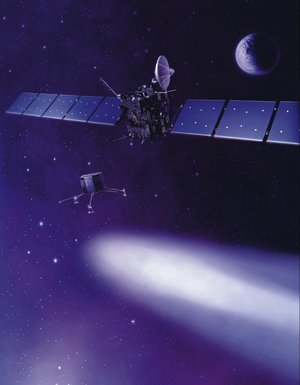
Rosetta and The Lander
In january 2003, ESA's Rosetta space probe launched on a nine year voyage to comet Wirtanen. Rosetta is the first probe that landed on a comet. This transmission is the third in a series of five TV Exchanges on Rosetta, and features the tecnological and operational challenges of landing on a comet. The Rosetta lander was the first space probe to make in-situ investigations on the surface of these remnants from the early history of our solar system.
The programme comprises of a 8-minute A- roll with split track and commentray and is complemnted by a B-Roll with clean international sound.
SCRIPT
The lander
00:40
After months of intense final assembly and technical check-outs, the Rosetta spacecraft starts its journey to the launch site Kourou on the other side of the globe inside its nitrogen-filled container.
00:52
At Schiphol Airport, near Amsterdam, the crew of the massive Russian Antonov cargo aircraft knows exactly what it has to do. Every manoeuvre, every manipulation is perfectly studied. It is not the first time they have to transport a satellite. It is also not the first time that a satellite is sent into space to analyse the structure of a comet. But so far, space probes only made fly-bys of a comet's nucleus: Vega, Giotto, Deep space or Contour to name the most prominent.
01:27
ESA's Rosetta mission is much more ambitious, it will fly to comet Wirtanen, orbit around the comet and realize one of the most exciting episodes in the history of space exploration: the first soft landing on a cosmic iceberg. Soft is in fact not the appropriate word to describe the challenge. Sci






